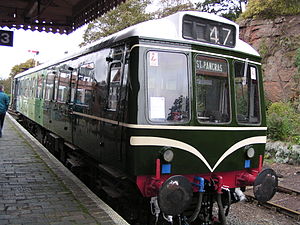British Rail Class 127
| British Rail Class 127 | |
|---|---|

Class 127, no, 51625 at Bewdley on the Severn Valley Railway on 15 October 2004, whilst on display at the Railcar 50 event. This vehicle has been part-restored to its original condition, having been rebuilt as a parcels unit (numbered 55976) in 1985. This vehicle is preserved at the Midland Railway Butterley, paired with driving motor 51591, and trailer 59609.
|
|
| In service | 1959–1989 |
| Manufacturer | BR Derby |
| Number built | 30 sets (120 vehicles) |
| Formation | 4-cars sets: DMBS + TSL + TS + DMBS |
| Capacity |
|
| Operator(s) | British Rail |
| Specifications | |
| Car length | 64 ft 0 in (19.51 m) |
| Width | 9 ft 3 in (2.82 m) |
| Height | 12 ft 4 1⁄2 in (3.772 m) |
| Maximum speed | 70 mph (113 km/h) |
| Weight |
|
| Prime mover(s) | Rolls-Royce C8NFLH, 2 per power car |
| Power output | 476 hp (355 kW) per power car |
| Transmission | Hydraulic |
| Multiple working | ■ Originally Blue Square but later changed to Red Triangle |
| Track gauge | 4 ft 8 1⁄2 in (1,435 mm) |
The British Rail Class 127 diesel multiple units were built by BR Derby in 1959. Thirty 4-car units were built, formed of two outer driving motor vehicles, sandwiching two intermediate trailers which were classified class 186. The technical description of such as 4-car unit was DMBS + TSL + TS + DMBS.
The units were almost exclusively used on London St. Pancras to Bedford commuter services, which earned the class the nickname "Bed-Pan" units. The class was maintained at a new purpose-built depot at Cricklewood.
Unlike other "Heritage" DMU units, the class 127 units had hydraulic transmission (as opposed to the more standard mechanical transmission). The gear selector in the driver's cab had a "D" position where "4" would be on other standard transmission units. As built, these units were coded Blue Square, and were therefore able to work with mechanical transmission units, provided the driver remembered to use 1,2,3,D instead of just selecting D. This was changed to a unique code of Red Triangle when a driver forgot he had a mechanical transmission unit on the rear of his train, which meant this unit was driven only in fourth gear, which burnt out the transmissions on that unit. Power was provided by C8NFLH engines supplied by Rolls-Royce. For further information on the powertrain see British Rail British United Traction.
The class 127 units operated one of the most intensive passenger services worked by diesel multiple units and, by the late 1970s, it was clear they needed replacing. It was therefore decided to electrify the Bedford line and replace the Class 127 units with new Class 317 electrical multiple units. The class 127 units should have been withdrawn by 1982, however, delays with the new trains meant they had to struggle on in service until July 1983. This was largely due to an industrial dispute with the unions over Driver only operation, which resulted in the new electric trains being stored at Cricklewood depot for nearly a year, awaiting the resolution of the dispute.
...
Wikipedia
